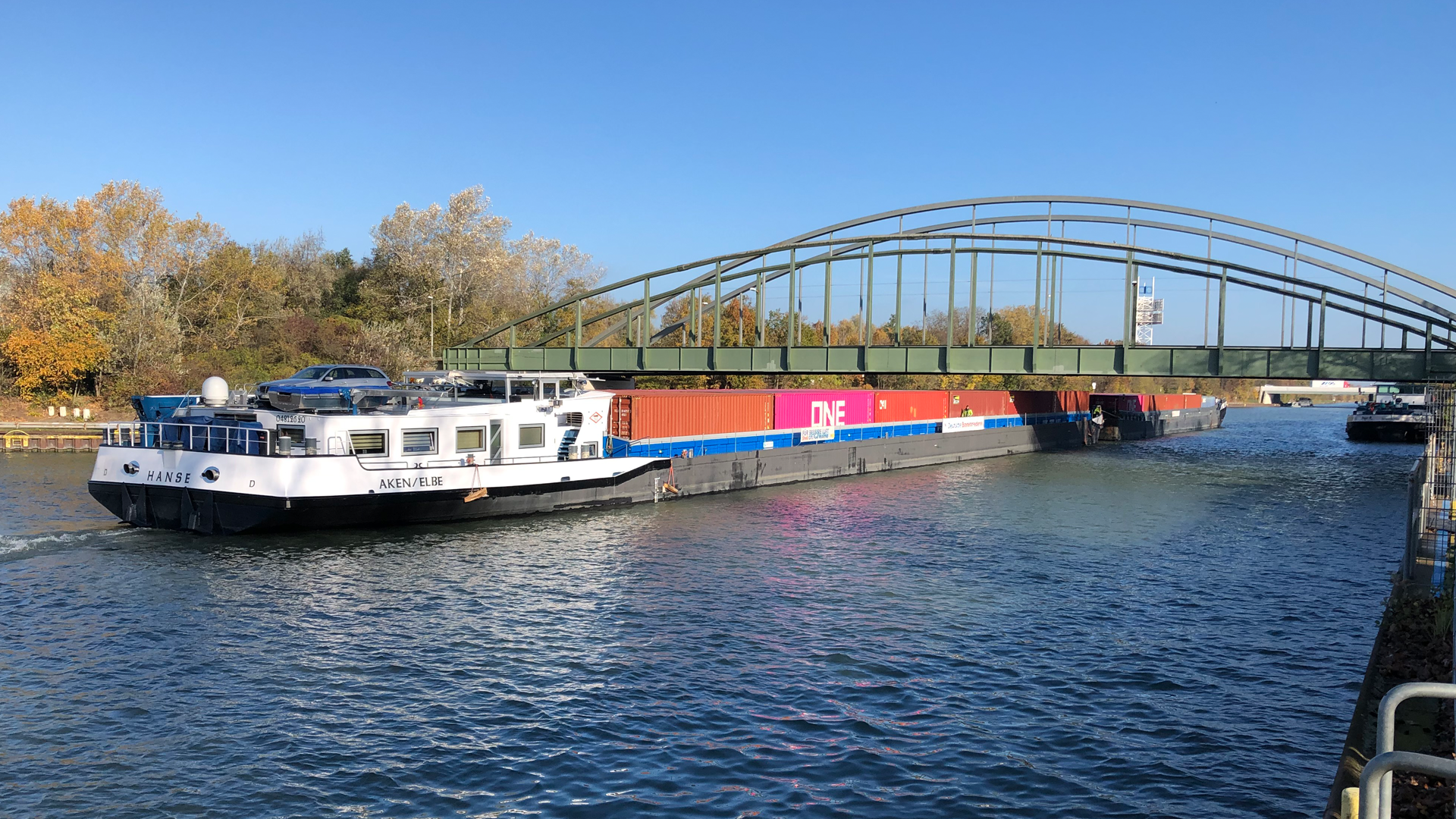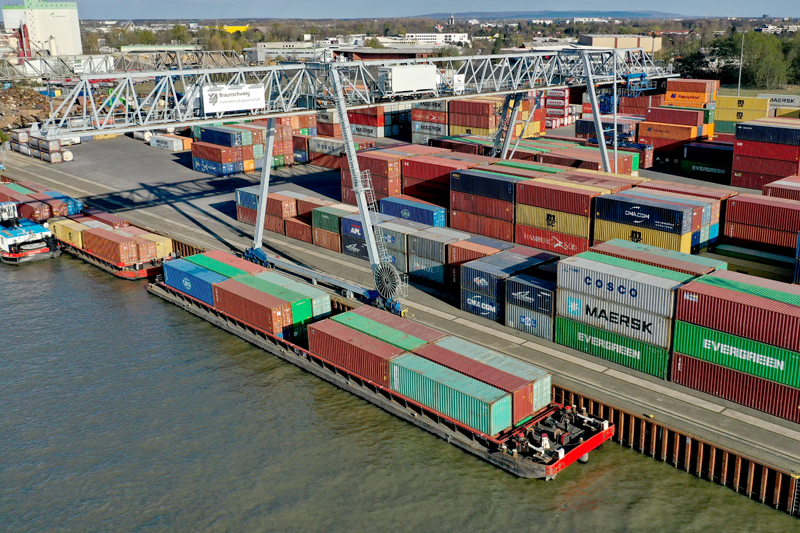Cameras and lasers have everything in their sights
Künz of Austria automates intermodal terminals ...

The fashion trade is a fast-moving business. For dealers, punctual arrival of clothing is tremendously important. As soon as time windows close, selling it becomes difficult. This also applies to Braunschweig-based fashion company New Yorker. “We must organize our purchasing logistics so that we have our collection here in the central warehouse in good time to distribute this to our branches,” says Stefan Heidler, New Yorker’s Logistics Manager. For some years now, the fashion company has relied on delivery by inland waterway vessel. Every year, around 11,000 standard containers reach Braunschweig for New Yorker from the Port of Hamburg via the Elbe Lateral Canal and Mittellandkanal. “For us, transport by inland waterway craft is not only the most environment- friendly solution, but also pays from the commercial point of view. That is what makes this form of transport so attractive,” emphasizes Heidler.
„11,000 standard container
come annually from the port of
Hamburger to Braunschweig
by barge for New Yorker"
For New Yorker, the most recent peak period has just ended. The autumn/winter collection is already hanging in its shops. Yet just now, the company is concerned about the state of the waterways. It was not just that precisely at peak time, the ship lifts at Scharnebeck had to closed completely for two days. “Basically, we have the impression that Federal government is not treating this waterway as it should. Even at the planning stage, many projects take years. That could gradually be a shot in the foot for us. Some action is badly needed here,“ says Heidler. For the logistics manager, namely, inland waterway craft lead the field for transport. “We have tested all manner of transport routes. In all conditions, the inland waterway craft was the best means of transport. Overall, it is faster, more flexible and reliable than rail,” says Heidler. There are a variety of reasons for this. It can take a while for all containers to be marshalled at Maschen. In addition, slots are required that are not so simple to obtain, and when it comes to volumes that fluctuate every week, the inland waterway craft quite simply offers more flexibility.
Yet there are even snags about this form of transport. For the post-carriage run from the Port of Hamburg to its Braunschweig head office, New Yorker reckons with seven days. Two of these follow release by the terminal operator, until New Yorker can collect. As soon as the containers reach the Port of Braunschweig, these are delivered to New Yorker. “ We give the Port of Braunschweig a prioritization list that it then works through, since again and again there will be consignments that we need more urgently,” says Heidler. The Port of Braunschweig then delivers the containers in the order requested. “In this case, we act like a forwarder for New Yorker and undertake all the tasks ranging from collection in the Port of Hamburg to delivery of individual containers to head office,” says Jens Hohls, CEO of the Port of Braunschweig Operating Company.
For container handling, Hohls has at least 250 metres of quaywall available, out of a total of 1.7 kilometres. Two container gantry cranes and three reachstackers ensure that containers find the right location. Covering 38,000 square metres, the facility also offers space for hazardous goods and reefer containers. This is well utilized. “With us, there is always a ship beneath the crane,” says Hohls. Yet these vessels are also permanently on the move between Hamburg and Braunschweig, For instance, the Port of Braunschweig offers daily sailings. Until now, it has been mainly Deutsche Binnenreederei push tows that have been deployed by the port. These can transport up to 108 TEU. “Yet at present, coupled tows meet growing acceptance. This combination of pusher tug and barges has a capacity of 166 TEU,” explains port manager Hohls. They do not deliver containers solely for New Yorker. Other shippers are also happy to use the Port of Braunschweig. Many export containers, for example, leave there for Hamburg. “Cargo volumes in each direction are almost the same, so that we need not deal with all that many empty containers. Yet we remain broadly positioned,” says Hohls, adding that: “New Yorker is definitely among our biggest customers.“

Digital communication between the Port of Braunschweig as service provider and New Yorker tends to be in traditional form. Yet this is changing just now. At the moment, the Port of Braunschweig is in the process of acquiring a terminal and transport management system. “As part of that, we shall have some new interfaces enabling us to link New Yorker to our system,” says Hohls. At the same time, New Yorker will be introducing a new central warehouse. All import containers will then be unloaded centrally. Our staff will pick all collections here for our worldwide stores. From here, these will continue by truck or air freight,” explains Heidler.
Yet before that stage is reached, the goods need to come to Braunschweig. These are successfully monitored through our ERP system. Staff can see there when each order has reached the manufacturer. As soon as the consignment boards the seagoing ship, the company can track the vessel with the freight. “We then know relatively precisely when the vessel will arrive in Hamburg, and can then plan the post-carriage run from the Port of Hamburg to Braunschweig in good time,” says Heidler. Five colleagues at head office look after this. An additional ten to fifteen of them are occupied with Customs clearance. For New Yorker, the inland waterway craft remains the best solution for transport into the hinterland, with three unbeatable arguments in its favour: Price, Reliability and Ecological Footprint.
Braunschweig Hafenbetriebsgesellschaft – Braunschweig Port Operating Company – is now a state-of-the-art logistics service provider plus a port. This not only provides handling in the port, but at the same time looks after pre- and post-voyage runs. Last year, 829,000 tons of cargo crossed the quaywalls. The port handled almost 78,000 TEU, with nearly 103,000 tons going by rail. This marked its successful transition from pure infrastructure to logistics service provider. The Port of Braunschweig’s history goes back considerably further. Back in 1227, official documents already mentioned unimpeded shipping between Braunschweig and Bremen. Down the centuries, the rivers then silted up. It was only with the building of the Mittellandkanal that Braunschweig again became a port in 1934. After the war, this became a frontier trading port. Cargoes were transferred from Eastern into Western tonnage, and vice versa. The draft of vessels in transit to Berlin was adapted to Elbe water levels. After the border was opened, this important part of its work ceased for the Port of Braunschweig. To secure work there, a start was made on revamping the Braunschweig Port Operating Company, then confined to infrastructure, as a logistics service provider.
Fashion group New Yorker now has more than 1,200 branches in 47 countries, employing over 23,000 staff. This makes the group one of the world’s largest international fashion brands. As an owner-managed group with its head office in Braunschweig, NEW YORKER combines the lean hierarchies of a family company with the international character of a major group. Its first shop opened in Flensburg in 1971, still with the name ‘Jeans Shop Number One’. Five years later, ‘Jeans House’, the first store in Braunschweig was added. Another six years passed until the first shop with today’s name ‘New Yorker’ opened in Kiel.